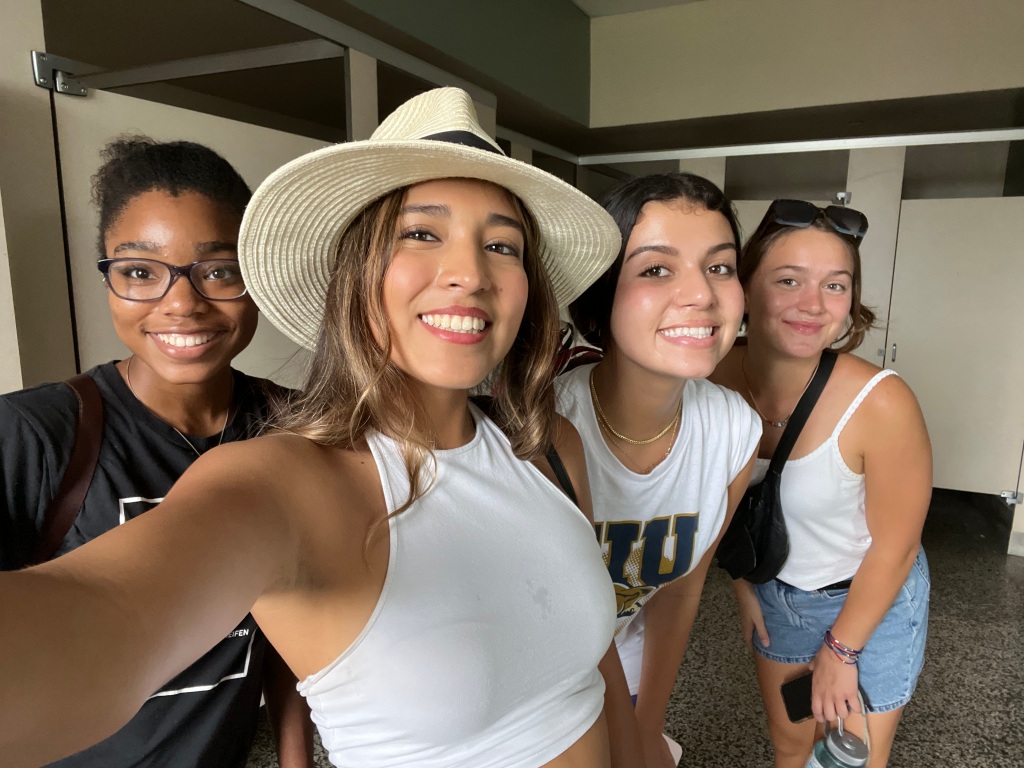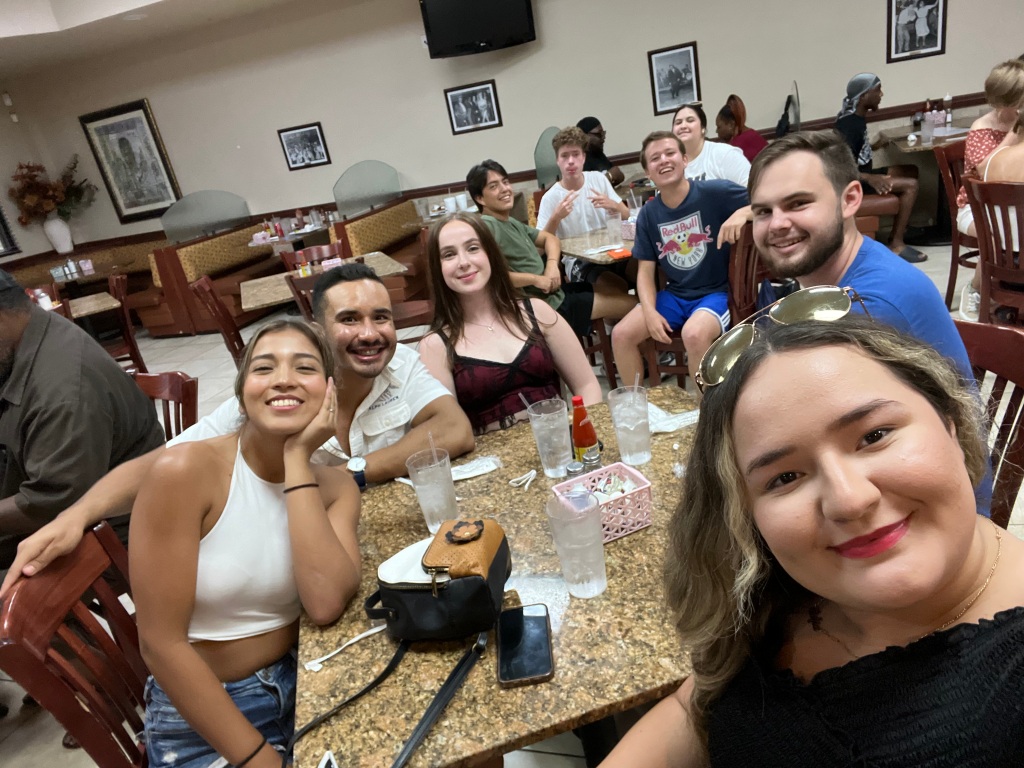
Downtown Miami as Text:
“The real voyage of discovery” by Kylee Andrade of FIU at Downtown Miami on August 31, 2022

As the French novelist, Marcel Proust, once said, “The real voyage of discovery consists not in seeking new landscapes, but in having new eyes”. Truly, this quote embodies my experience while roaming the peculiar streets of downtown Miami. Living in Miami for the past two years and not experiencing the cultural and historic wonders that Miami has to offer left me speechless once my journey to venture into the downtown streets of Miami began on August 31st. Being able to view the city of Miami with “new eyes”, inspired me to embark on the “real voyage of discovery” as I finally learned and reflected on Miami’s hidden history. The day of exploration felt as if Miami itself had narrated its past and its future with its marveling architectural wonders and culturally rich environment. No one could have prepared me for such a historical narrative, scenery, and atmosphere. Just being surrounded by the immensity of such buildings and the authenticity of the historical locations filled my heart with not only joy but a newfound curiosity for the desire to learn more…experience… even feel the emotion that the city itself conveys. Once in the heart of the Government Center, the seat of the Miami-Dade local government, we embarked on the emotion-filled journey to learn more about Miami’s past.


In July 1896, Julia Tuttle founded one of the only cities in the U.S. to have ever been founded by a woman which was Miami. Genuinely, this fact filled me with great emotion and joy as learning that a woman had pioneered the creation of a famous city was an accomplishment I felt proud of as a woman. This historical trinket was not the only hidden gem Miami had to offer that day as walking to the Wagner Family House and learning about the inspiring history behind one of the oldest structures in Miami proved to be quite extraordinary. The house had been home to the interracial couple William Wagner, a German immigrant, and Eveline Aimar, a French-Creole immigrant. Sadly, during this time in history, racism still stained society’s perspective and treatment of colored people which explained why the children of such family had faced discrimination and prejudice for the color of their skin. However, this story is notable for the family’s close relationship with the Seminoles as they acted as the mediator between the Seminoles and the Northern settlers. I mentioned the history of the Wagner home because hearing about the curious connection between the Wagner Family and the Indians had fostered a feeling of appreciation for the Wagner Family as their friendliness and generosity not only shattered the barriers between such ethnic groups but represented a symbol of peace for the healthy co-living of both entities.

Truly, another impactful site proved to be the Fort Dallas/William English plantation slave quarters as the native construction had been utilized as the U.S. Army barracks after Fort Dallas was re-established during the Second and Third Seminole Wars. Touching the limestone walls was an experience that registered to be one of my core memories as I wasn’t just simply feeling the sturdy walls at my fingertips but rather envisioning the historical context through the eyes of the slaves that had lived… who touched those same walls before. Yet, I also found myself imagining the quality of life for not only the slaves that lived there before but for the Army soldiers that had also occupied the English plantation. I started to envision the fear… chaos… stress that could have possibly infected their minds throughout the Seminole Wars. The emotions that may be evoked through the simple observation of a new perspective and all the history behind such was truly one of the most unforgettable moments throughout the venture of the trip.


Lastly, a historic wonder that filled my mind with overwhelming frustration and genuine shock was the Major Dade Plaque located in the Miami-Dade County Courthouse. The history behind the origin of the word “Dade” in “Miami-Dade” was one of the most shocking turning points in the trip as nothing prepared me for the horrifying and morbid story behind the individual whose name was bestowed upon one of the counties in Miami. Here’s the story… During the Indian Wars, the U.S. Federal government sent reinforcements to defeat the Seminoles in 1835. The commander in charge of such troops was Major Francis Langhorne Dade who arrogantly led his troops to an ambush as he underestimated the potent force of the Seminoles which resulted in a regretful massacre. So why would we bestow Major Dade’s last name to the name of one of Miami’s counties? Why give him that honor? Why reward his blood-stained legacy? Shouldn’t we be ashamed of this history and not display it as a plaque? Now, you can see why this historical artifact, the Miami Dade Plaque, genuinely appalled me. However, I gained true appreciation learning about the disturbing history behind Miami-Dade county’s name because where there is knowledge… there is growth and learning about the past, whether it is ugly or beautiful, is always important.

Ultimately, the journey to discovering the ancient history behind the complicated yet beautiful city of Miami was one of the most educational and emotion-filled voyages of my life. Being able to touch, feel, observe, and experience Miami from a different cultural and historical perspective was truly an honor for which I’m compelled to share with others so that the beauty and history of the city may never go unnoticed.
Overtown Miami as Text:
“A stone of hope” by Kylee Andrade of FIU at Overtown Miami on September 25, 2022
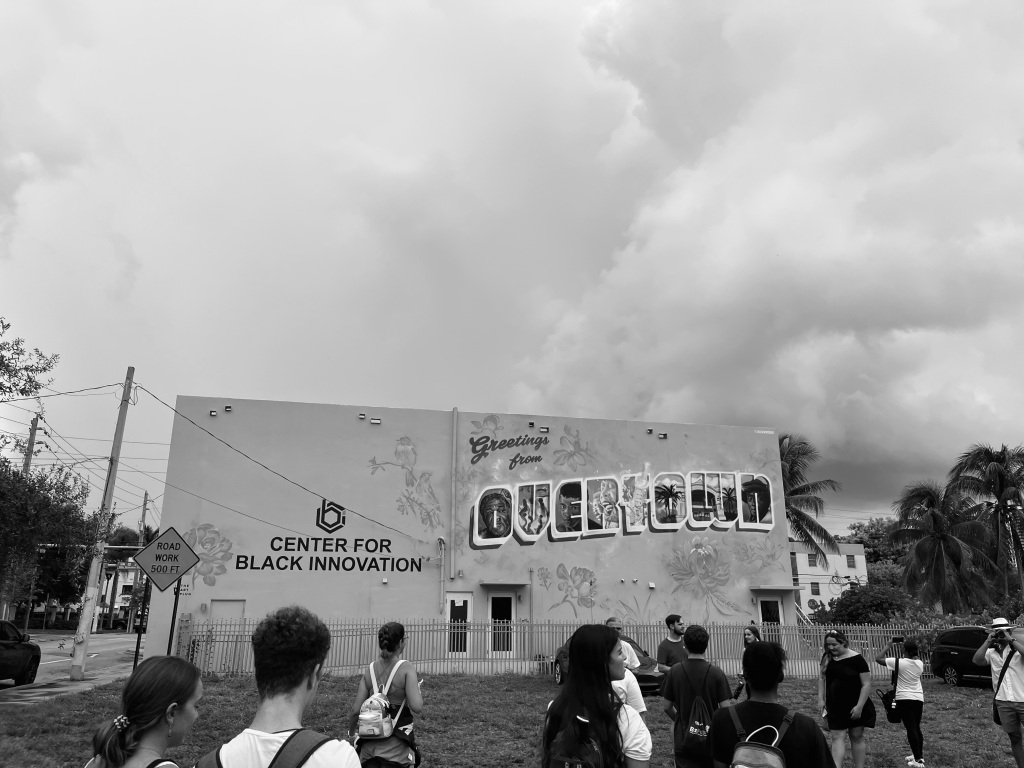
Martin Luther King once said, “Out of the mountain of despair, came a stone of hope”. Truly, this quote beautifully represents the dual experience of hope and frustration that I sense throughout our journey to Miami’s “Overtown”. It was a brutal experience to learn that despite the cultural, economic, and industrial value that the black community brought to Miami, black individuals were still segregated and treated with nothing but disdain. As if it wasn’t enough for the black community to be ostracized from society, their communities were shattered with the establishment of the I-95 and I—395 expressways which ultimately displaced black community centers, businesses, and churches. Nevertheless, the black community faced this challenge with great vigor as Overtown continues to flourish as a culturally rich and thriving neighborhood filled with historic buildings and individuals with welcoming hearts. Thus, out of a mountain of pain and struggle from segregation and discrimination, came a wave of resilience and cultural pride.
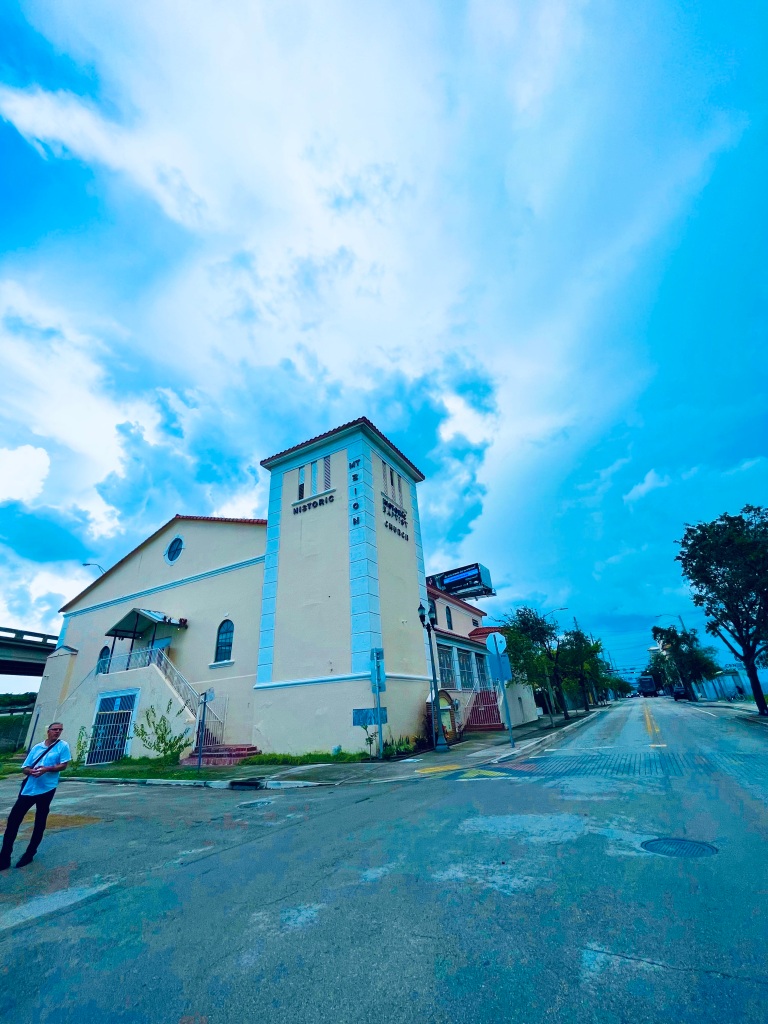
Photograph taken and edited by Kylee Andrade/ CC by 4.0.
As previously mentioned, learning about the separation of black communities from the construction of I-95 and I-395 was one of the most shocking and disturbing realities I learned as I could not fathom how the city would conveniently allow the black communities to be displaced. Specifically, the establishment of such expressways not only shattered black communities but also separated them from their vital centers such as churches and schools which was now less accessible because of the protruding roads. At this point, I remember feeling extremely overwhelmed at how unjustly the black community in Miami had been treated. Truly, I always thought Miami was welcoming of diversity as I considered it to be a melting pot of all cultures and ethnicities. However, witnessing the I-95 expressway in our journey served to be a turning point for me as I slowly realized the brutal reality of Miami’s disturbing history of slavery and segregation even though the lifeline of the city was founded by black laborers and workers. As I reminisced about the struggles of the black communities living in such an era of horror and hostility, we had advanced towards the Greater Bethel African Methodist Episcopal Church.
All photographs taken and edited by Kylee Andrade/ CC by 4.0.
Undoubtedly, the highlight of the journey to Overtown was visiting Greater Bethel Church which is one of the oldest black churches in Miami and is entirely funded by the congregation. Walking through the doors of the white church, I felt a wave of joy as I knew we had entered the same doors as Martin Luther King Jr. had when he gave the speech about voter registration on 12 February 1958. Seeing the wooden benches, the tall standing pulpit, the short glossed tables for the sermons, and the stained glass art depicting classical scenes from the Bible was a baffling experience for me as I was surrounded by so much historic beauty. This had been my first experience entering the doors of a church since I was 10 years old which reminded me a lot about the churches I would attend to when I lived in Ecuador when I was a toddler as both churches carried the same architectural layout and religious artwork. Genuinely, the Greater Bethel Church had triggered childhood memories which made me feel extremely connected to the value the church had for black communities. Thus, learning that the congregation was displaced ever since I-95 split black neighborhoods evoked a crippling sense of despair and frustration since, as described by Walter, the church was no longer the same.
Photograph taken and edited by Kylee Andrade/ CC by 4.0.
Ultimately, the journey to discovering Overtown was a truly unforgettable experience as I learned the history of the black communities in Miami and how, despite segregation and discrimination, their culture potently flourished with great pride and resilience. Being able to taste the soul foods of the community and witness historical buildings such as churches and recreational centers from Overtown was a bewildering experience. Even though there is great darkness in Miami’s past, there is also great beauty from the communities that founded their homes and families in such a captivating city with vast cultural richness and authenticity.
Biscayne Bay Chicken Key as Text
“Miami’s small wonders” by Kylee Andrade of FIU at Chicken Key Miami on October 5th, 2022.

Mahatma Ghani once said, “The best way to find yourself is to lose yourself in the service of others”. Truly, this quote resonates with me as our class was given the opportunity to help our local island, Chicken Key, by cleaning up marine debris and trash surrounding the aquatic ecosystem, endangering countless of marine life. Being able to give back to not only our city but to our planet was a great way to inspire a spirit of change and community for our class. Moreover, the cinematic views of the ocean, the mangroves, the islands, the birds, the colorful fishes, and the bright green/blue water was an experience that I will forever cherish in my heart as I got to truly view Miami as a city of not only nightlife and party but as a city inhabiting aquatic beauty and wonder.
Embarking on our journey
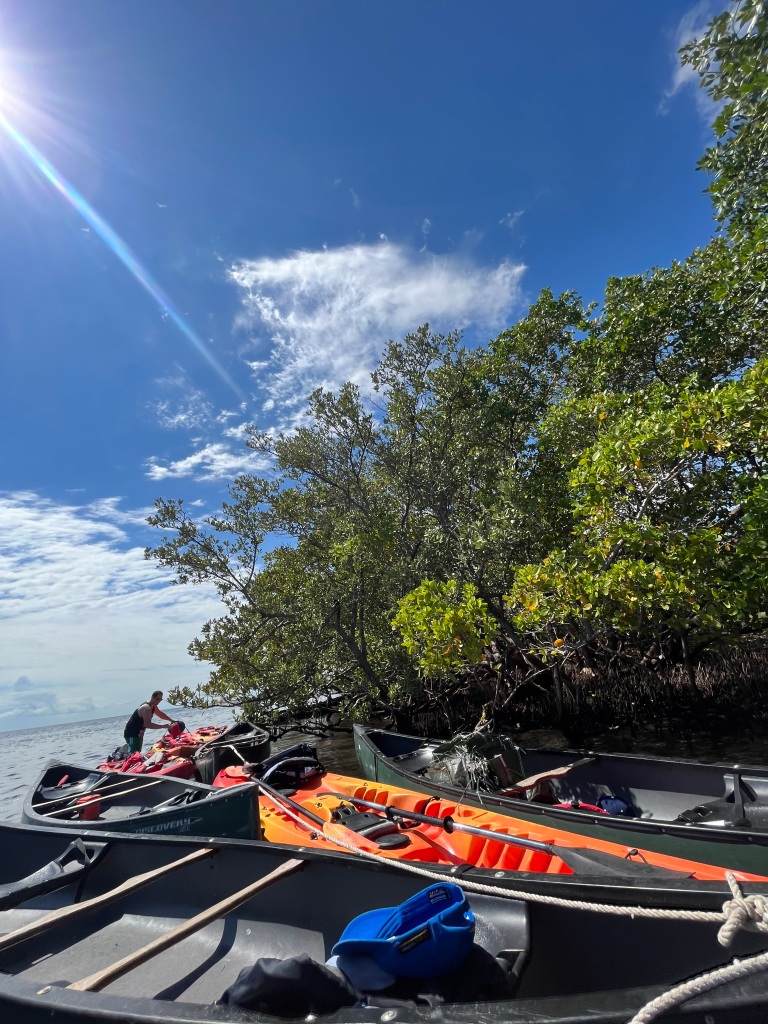
As we made our way to our kayaks in order to arrive to Chicken Key, I was pretty nervous about kayaking as I never kayaked before. Yet, I was filled with great excitement knowing I would get to see the beautiful marine life that Miami had to offer. Thus, embarking on our kayaks with our class was a great experience as I was able to enjoy feelings of excitement and nervousness with those around me. Being able to see their faces lit with joy as we ventured through mangroves and islands under the bright sun was an experience of pure delight. Growing up in a school system where classes are taken within four restricting walls for the duration of long hours throughout the day had always left me feeling defeated and overwhelmed. Truly, I never really learned about the topics we were taught as the environment and teachers felt draining and depressing. However, having the opportunity of being taught in many beautiful yet historical outdoor environments has been an experience I have been so grateful for as learning about Miami has never felt more exciting and interactive. Therefore, learning about Biscayne Bay, the Deering Estate, and our local islands (Chicken key) as we view baby manatees, mangroves, seagrass, corals, and aquatic life that Miami has to offer has been an unforgettable yet the most educational experience I have ever had.
Serving our community

Due to extenuating circumstances, I was unable to participate in the clean-up of Chicken Key. Nevertheless, I wanted to educate those who are reading this blog post about the dangers our aquatic life is currently threatened by and what we could do to create a positive impact for our fellow marine communities. As we learned and saw on our trip, our oceans are violated with pollutants such as metal, plastic waste, man-made items, manufactured waste, paper debris, food wrappers, bottle cans, fishing gear, derelict vessels and so much more. Not only are some items listed not biodegradable, but they are threatening to our aquatic ecosystems which nourish our marine life. Truly, we must be careful of the type of footprint we want to have in our ecosphere since we, as educated citizens, have the choice to leave a harmful/careless footprint or leave a footprint of conservation and restoration on our planet. At the end of the day, it is not only the ecosystem we are harming but ourselves as life cannot simply exist without mother nature. Thus, I encourage those who are reading to take an extra second to think about the impact one careless behavior (littering, illegal fishing, marine dumping, etc.) can represent for our environment in charge of nourishing our existence.
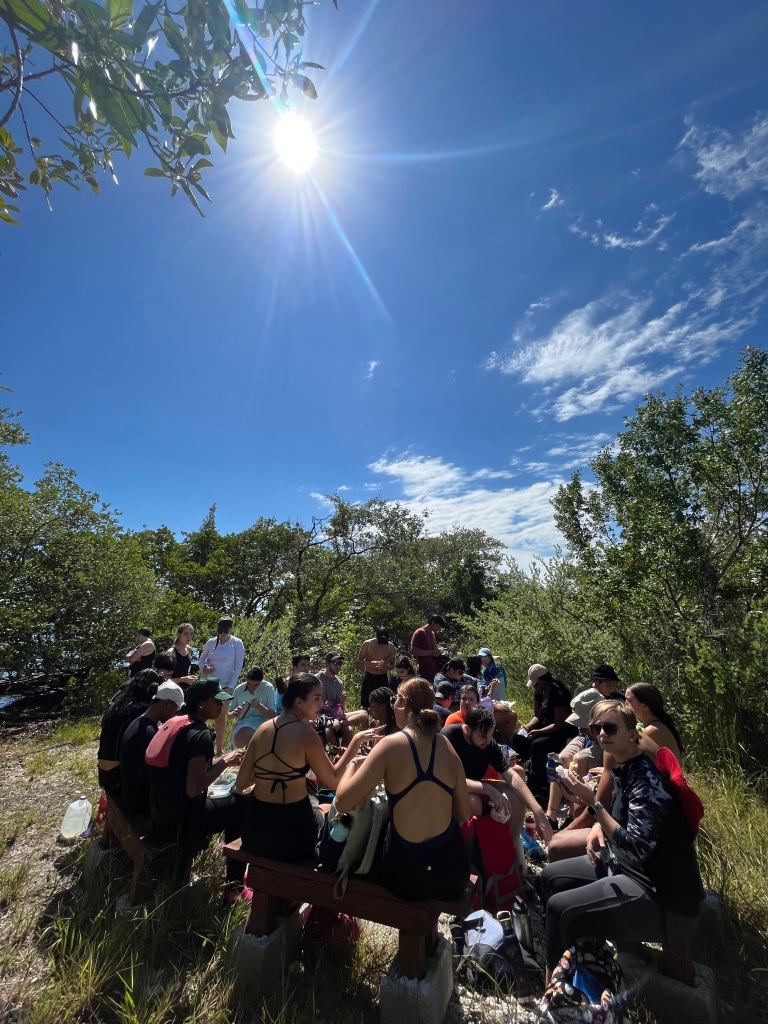
Overall, my experience at Chicken Key was truly inspiring as witnessing our aquatic life was an exciting and jovial experience. Being able to learn and personally view the natural wonders Miami has to offer as having the opportunity to directly contribute to the restoration of our aquatic communities with simple acts such as clean-ups was an honor. Lastly, I was able to view Miami as not only a tourist location for nightlife and astounding buildings but as a city fostering breathtaking biodiversity and ecosystems.
Vizcaya as Text
“The gifts of the present” by Kylee Andrade of FIU at Vizcaya Miami on October 20th, 2022.

As professor Bailly mentioned, James Deering once said, “gladly accept gifts from the present and abandon serious things from the past”. Throughout our journey to the Vizcaya Museum and Gardens, such words never left my mind as I began to recognize how valuable living in the present moment is. Being able to cherish every second and truly indulge in life is a lifestyle I greatly admire in European culture. Being able to take a second to observe, taste, smell, and experience the beauty in our surroundings whether it be grasping architectural sites, savoring dishes, or rejoicing in dance, is something truly extraordinary. And this is exactly what our class did. We took the pleasure of observing every architectural wonder, animated paintings, extravagant amenities, and breathtaking views that Vizcaya had to offer.
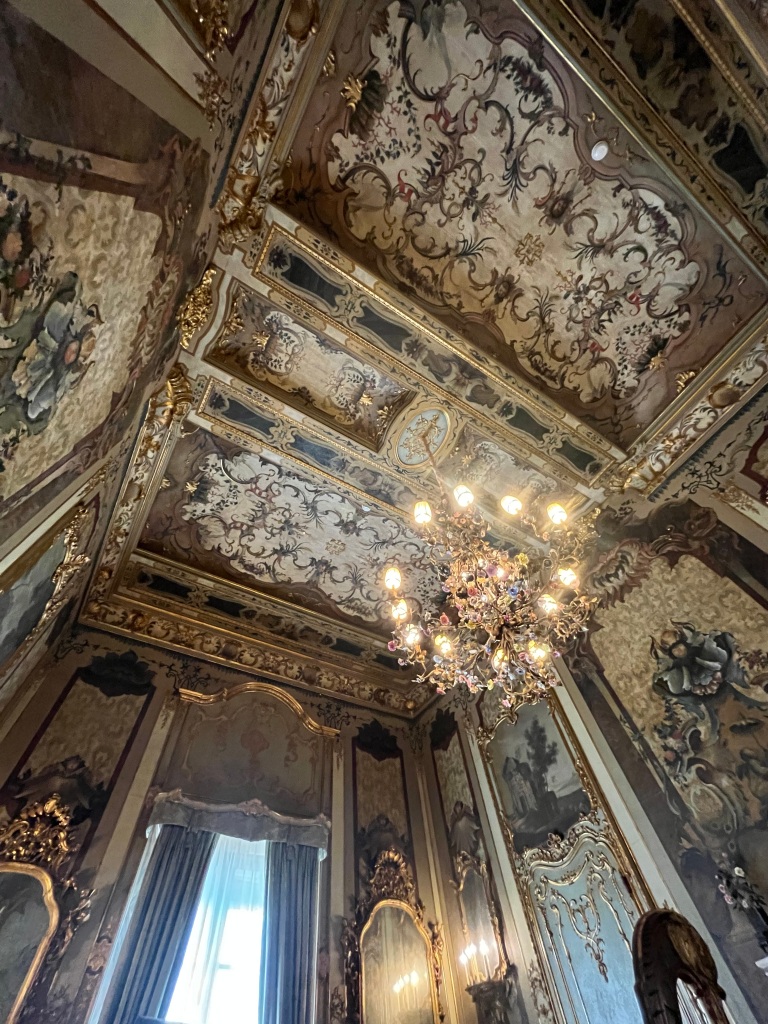
One of the most awe-striking moments of our journey to Vizcaya was witnessing the beautiful artwork decorating the ceilings and walls, leaving me in a total trans as I tried taking in every detail on the Rococo styled paintings. The gold paint ornamenting the room evoked a feeling of elegance and suaveness that tied the paintings, tapestries, and instruments altogether. Even the room carried a different essence to it as the air carried a whimsical and graceful spirit with the Rococo features gripping the room with the asymmetry, white and pastel colors, scrolling curves, and decorative undulations. However, I was truly enamored with the chandelier in the center of the room that carried the most detailed and pastel-colored flowers with gilded branch leaves and bright shining lights that circled throughout the piece. I was so amazed and astonished at such an alluring chandelier that I began to lose myself in thought about how long the artist or designer of the piece had to take to create the chandelier… the amount of time… the energy… the money that it took to produce such a masterpiece. And at this moment, I realized I was living in the present moment as I was truly conscient about the detailed features in the room which helped me comprehend the “gifts” that being in the present moment offers as James Deering had said.
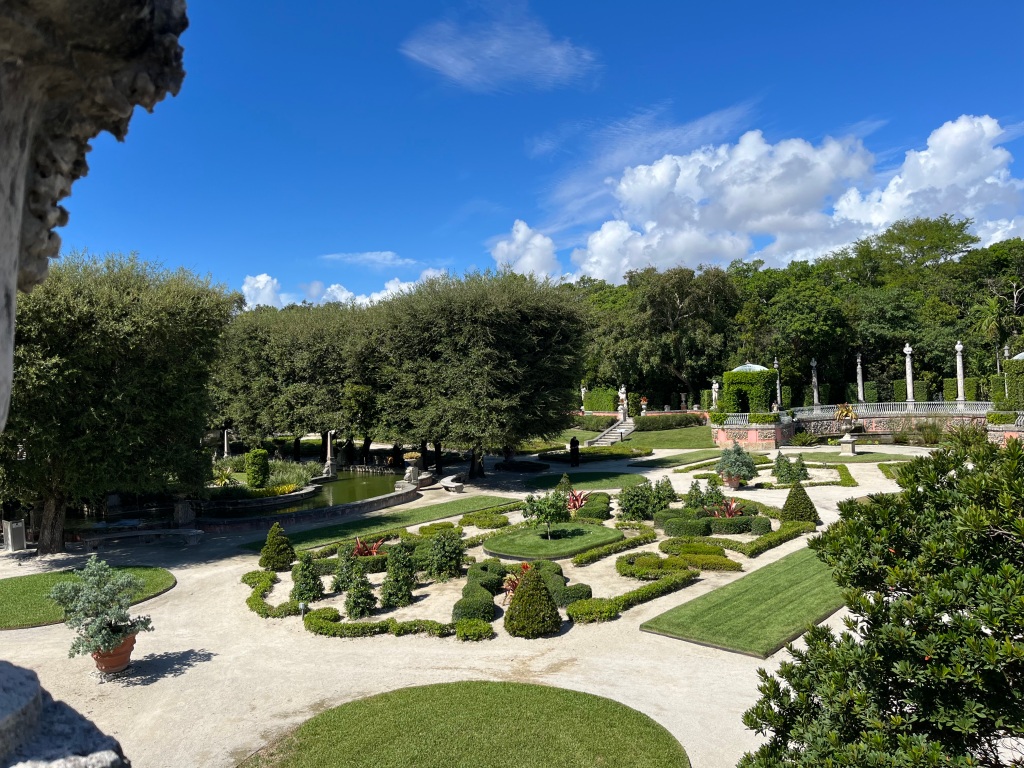
Another delightful and enchanting site included the Vizcaya gardens which were filled with the most vibrant greenery, animated statues, and majestical water fountains that allowed me to truly encompass the rich and lavish spirit that James Deering had. One of the most emotion-evoking sites was, without a doubt, the small and private garden just outside the establishment. Hearing that, in past times, private gardens were utilized to meet up with and have secret conversations with individuals from the lower and upper classes was so fascinating. I was lost in thought as I envisioned myself in the past entities of those who had walked those same gardens with great curiosity about what type of interactions such individuals may have had. Could the interactions be to hide a secret affair? Could the interactions be to hide a friendship with a lower-class individual? Were the conversations about business? Were the conversations about deep secrets that such individuals swore to never tell? At this moment, I remember thinking to myself how lost again I was in the present moment with the beautiful site of the Vizcaya Gardens and the secrets I may never know that took place in it.

Overall, the Vizcaya Museum and Gardens is one of the most breathtaking locations that Miami has to offer as it is filled with extravagant rooms with detailed ornamentation and artifacts rich in history. Moreover, Vizcaya’s gardens are incomparable and truly memorable with vibrant greenery and majestical statues that bring you back to indulging in such present moments. Truly, Vizcaya brings alive the quote by James Deering where the present moments are the true “gifts” of the journey, and experiencing such with great intention allows you to truly live.
South Beach as Text
“A cultural melting pot” by Kylee Andrade of FIU at South Beach Miami on October 26th, 2022.

Walking down the Ocean Drive in South Beach was such an overwhelming and extraordinary experience as observing every architectural style and décor in the buildings down the boulevard was such an enigmatic experience. Learning about South Beach’s rich history and the culturally diverse architecture truly allowed me to understand the meaning behind Miami being considered a “cultural melting pot”. Each building down Ocean Drive had a story to tell as each combined a different architectural design such as Art Deco, Memo, and Mediterranean revival. Personally, I’ve visited South Beach Pier and Ocean Drive so many times. Yet, I never stopped to understand why the buildings carried certain pastel colors, shapes, textures, and designs. I never understood the importance that world history had on the architectural designs and styles of such buildings in South Beach. Thus, this began my fascination with understanding the true beauty behind South Beach’s history.

Not only did the buildings in South Beach carry the beauty and diverse culture of the architectural designs popular in the world around that era, but it also carried buildings that carried fascinating criminal accounts during that same era in such city. As shown above, the establishment that most intrigued me, by not only its architectural beauty but also by its history, was the Gianni Versace Mansion. The story behind the Gianni Versace building was truly shocking as it represented complicated relationship between United States in that era with the LGBTQ+ community. As Gianni Versace, designer of the Versace clothing line, was open about his sexual orientation to men, others like Andrew Cunanan envied such who were able to be openly gay without much repercussion which is one the reasons that is believed as to why Andrew Cunanan killed Gianni Versace. Nevertheless, this brutal murder is a reminder of how the city of Miami had inhumanly treated gay people who, at the time, were harassed and arrested by the police on many discriminatory accounts. Nevertheless, Miami’s history is not all filled with darkness and injustice but rather strong female activist who transformed the history of Miami as we know it.
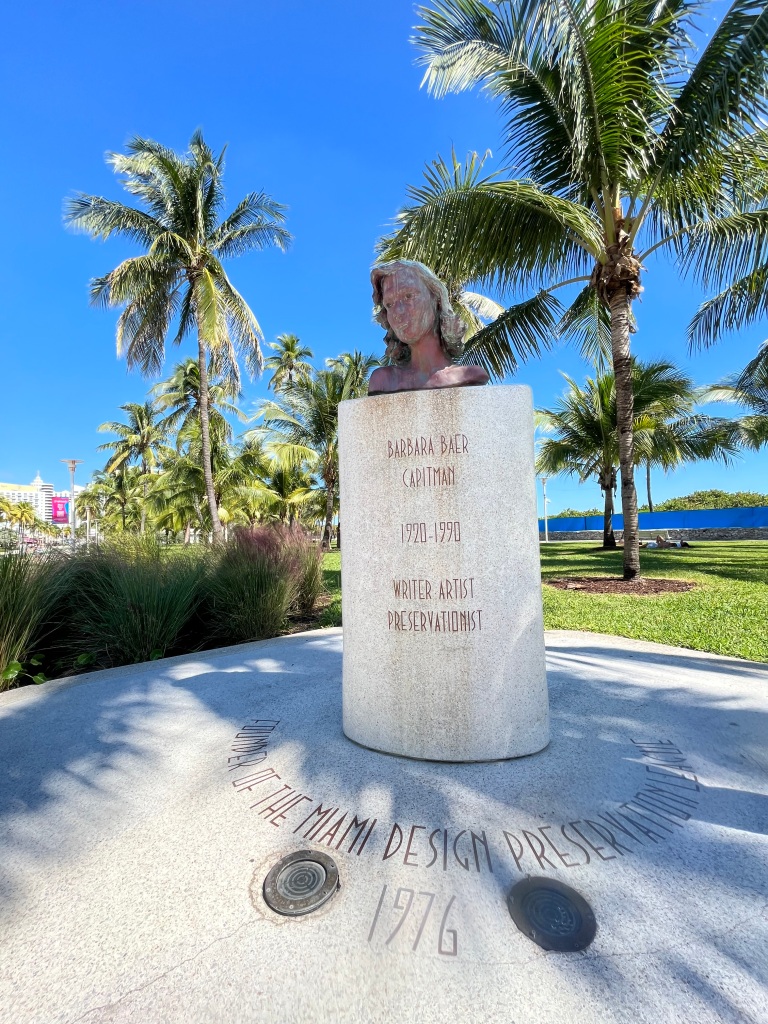
As demonstrated above, one of Miami’s most influential women figures was Barbara Baer Capitman whose memory is honored with the iconic sculpture along Ocean Drive. It was because of Barbara that South Beach’s Art Deco inspired neighborhood was kept and maintained as the nation’s first 20th century National Historic District. Barbara alongside with Leonard Horowitz founded the Miami Design Preservation League (MDPL) which protected the culture and unique architecture that makes Miami such an extraordinary tourist destination. Truly, if it wasn’t for the activism of Barbara, who fought so hard to maintain the authenticity and veracity of South Beach’s art and design, Miami would have never flourished socially and economically as Miami’s renown tourism would have significantly dropped if not at all existed. Thus, Barbara should not be forgotten in our history books and rather be celebrated as one of the most influential females figures in the history of Miami.

Overall, the journey to South Beach was a truly remarkable experience as I got to witness the most intriguing yet fascinating architecture that Miami has to offer. Specifically, the history that surrounds each building carries a special story of its own which truly adds to the overall value of Miami’s rich but complicated history. Lastly, the important figures that fought so hard to keep the spirit of Miami’s art and design alive should not be forgotten such as Barbara Capitman proved, through her activism and resilience, that South Beach’s vibrant architecture should be protected in order to preserve the authentic cultural melting pot of Miami
Deering Estate as Text
“Hidden Treasures” by Kylee Andrade of FIU at Deering Estate Miami on November 16th, 2022.

Photograph taken and edited by Kylee Andrade/ CC by 4.0.
Upon entering the gate of Deering Estate, I felt a rush of excitement knowing that our day would be filled with hiking and sightseeing. The thought of seeing multiple ecosystems in one long hike was astounding to me as I only ever get to see one ecosystem in Miami at a time before traveling miles to see another one. Truly, Deering Estate’s nature preserves, creeks, fossil sites, crashed plane sites, freshwater springs, rock ridges, solution holes, and burial mounds highlighted the beauty and the historical mystery that this journey had to offer. Although the hike was long, the experience of hearing how once Paleo-Indians walked these same paths was unforgettable and opened my eyes to the historical treasures hidden within Miami.

Photograph taken and edited by Kylee Andrade/ CC by 4.0.
One of the most astonishing sites this journey had to offer was that of the airplane crash site. The reason for why it was an awe-striking experience for me to see the remains of a crashed plane in front of my eyes is because of the many stories I’ve heard growing up from my family and teachers explaining how one of Miami’s significant economic sources was that of the drug trafficking industry which once brought about 5 billion into Miami banks during the 1980s. Therefore, hearing the myths of drug trafficking stories from my parents and seeing dramatized TV shows about Miami’s involvement in the drug trafficking operations with the Cali and Medellin Cartel in Colombia was something I grew up hearing and seeing but not always believing. However, witnessing the crashed plane site was a symbol of how those “myths” and stories had truth behind them and how valuable the drug trafficking industry had been in Miami. Seeing the ruptures and fissures from the crashed plane inspired a spirit of curiosity within me questioning… How could anyone survive this crash? Did the crash only carry cocaine? What cartel did this plane or drugs belong to? How much money was lost? These are the types of inquisitive moments that Deering Estate evokes.

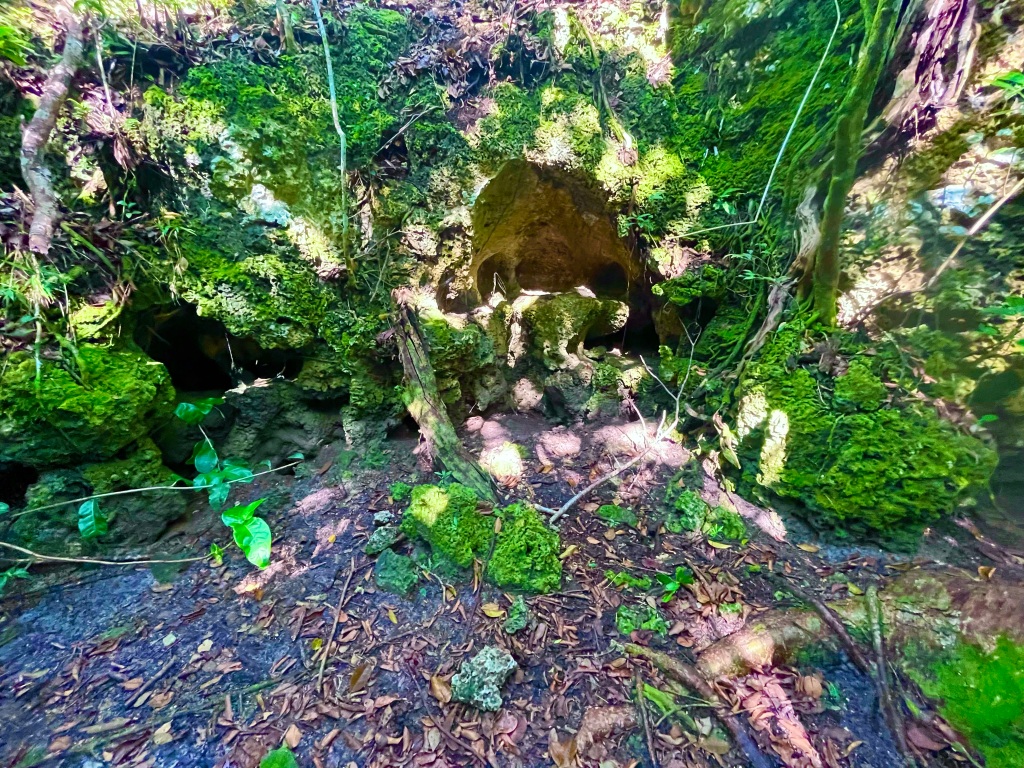
Photograph taken and edited by Kylee Andrade/ CC by 4.0.
Another astounding moment in this journey had been witnessing that of the Cutler Fossil site. Witnessing the limestone-layered sinkhole was incredible as I got to observe and touch the ancient fossils of dire wolfs and man-made tools utilized by Paleo-Indians. Knowing that human life existed in Florida for the past 10,000 years was shocking because I never imagined that Miami carried ancient historical value as the only sites people only ever talk about are Miami’s beaches, nightclubs, and tourist locations. Many mainstream TV shows and movies only display Miami through this modern and contemporary light as they highlight the night-live, high-end restaurants, fashion stores, exorbitant glass buildings, expensive cars, and luxury mansions but they fail to mention the most fascinating fact that Miami carries riveting sites where human life was found to exist for more than 1,000 decades! Knowing the hidden value that Miami carries had transformed my perspective about how significant history is in telling a story from a completely different outlook on what life had been for Paleo-Indians and how historical events can alter the current state of our society and people.
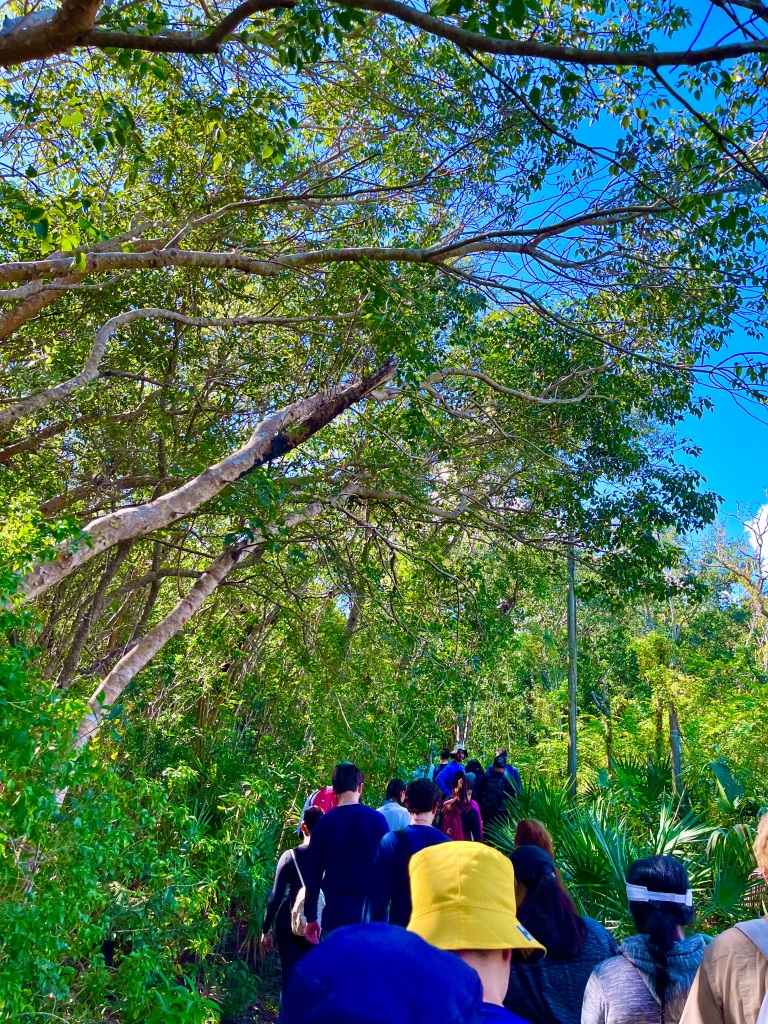
Photograph taken and edited by Kylee Andrade/ CC by 4.0.
Overall, this journey has carried the best moments and experiences as I had the opportunity to feel history by touching the same tools, walking the same paths, and witnessing the same natural habitats that Paleo-Indians had once lived in. This journey was absolutely unforgettable with thought-provoking sites and many beautiful natural ecosystems to hike through. If there is one thing I’ve learned throughout this experience is that we must not fall victim to only believing the representation that mainstream media offers about people or locations as many times it fails to acknowledge the true value and historical beauty that such places may have. We must dig a little deeper to discover the wonders that may have been hidden under our noses this entire time!
Rubell Museum as Text
“The hidden messages” by Kylee Andrade of FIU at Rubell Museum Miami on November 23rd, 2022.
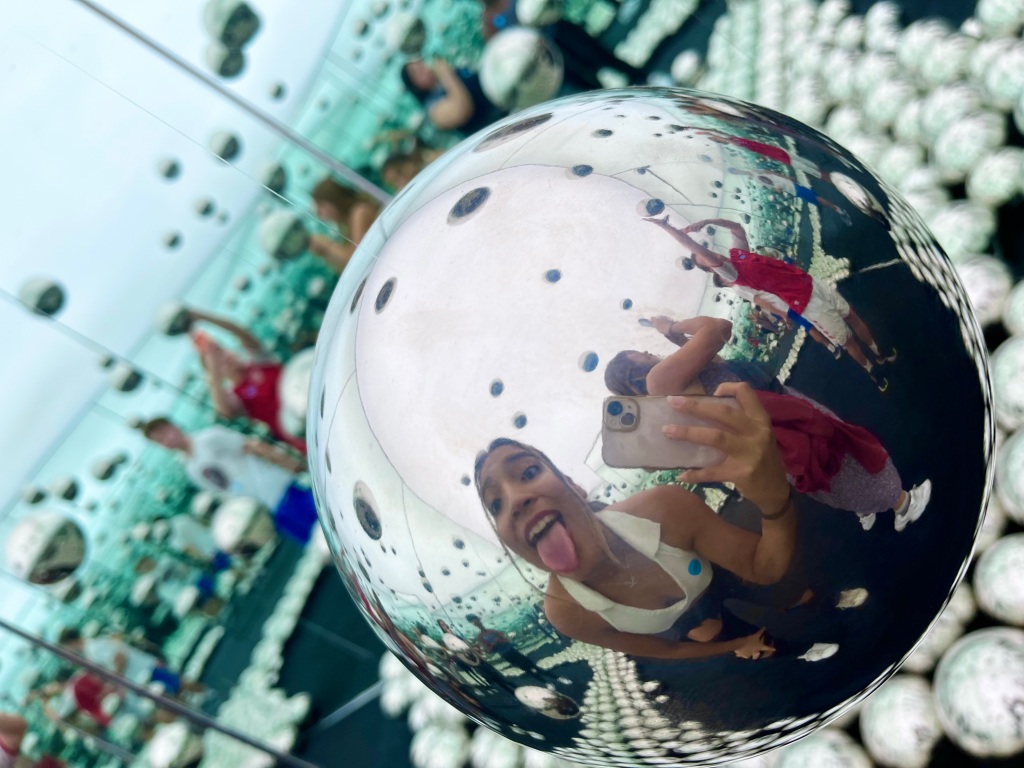
Photograph taken and edited by Kylee Andrade/ CC by 4.0.
Visiting the Rubell Museum was truly a unique experience as I had never entered an Art Museum in Miami filled with contemporary art and installations. As a matter of fact, I had never heard of the word installations in the world of art which was something I got to experience when visiting this museum. Truly, I was at a loss for words when seeing the sculptures with through-provoking imagery and rooms filled with marveling objects and mirrors. I learned that art carried more than just colors and mediums but also hidden messages that re-imagine the manner in which you can view life or yourself, deepening your connection to the experience that art evokes.
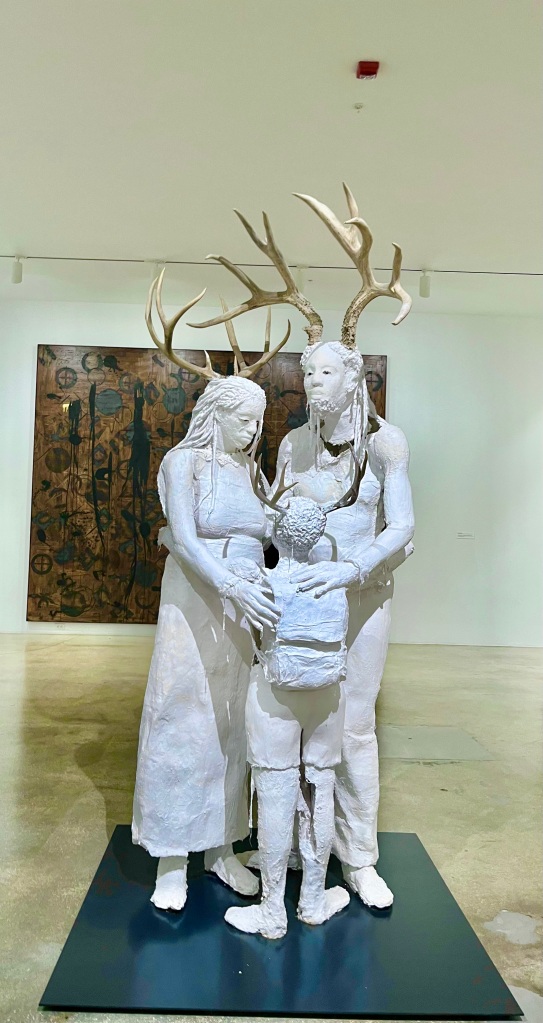
Photograph taken and edited by Kylee Andrade/ CC by 4.0.
One example of viewing past the painting or sculpture of an artwork is the hidden message of the art piece above. The reason for why I chose to talk about this beautiful sculpture is not only because of the detailed work that this piece carries but also the activist message hidden inside it. At first sight, one can initially think that this is a happy family hugging each other after their son has just come back from school. However, if we take a closer look the parents look concerned and empathetic as if comforting the child. Truly, the eyes of the parents are heartbreaking as they are filled with pain and melancholy. Taking a further look, one can also observe antlers on the parents’ heads… but what does this mean? As further explained, this piece was used to embody the experience of black families having to comfort their children after returning from school from countless experiences of racism and discrimination. The antlers symbolize how black people were outcasted and targeted by society in an era where the black community was simply violated for their skin color… Truly, this piece is a symbol of activism as it lets us look at people with more empathy and humanity since we are all human and worthy of benevolence. Because of this piece… its imagery, details, and message, I became more connected to the artwork and the events in our history that sometimes we forget even happened. This is why art exists…to remind and warn us of our past and amend the future we can live in.

Photograph taken and edited by Kylee Andrade/ CC by 4.0.
Another piece that was extremely intriguing to understand was that of the self-portrait of the Rubell’s. When looking at this piece, one would never guess how this artwork reflects a self-portrait of a long-lasting couple. Truly, it looks like an old and used mattress. However, the deeper message behind this piece is the fact that this piece symbolizes all the journey filled with many years of the couple’s emotions, experiences, memories, and life together. After grasping the message of the piece. I had a more profound appreciation for art and the beautiful moments it comes to symbolize in the most intriguing and marveling ways. Like this couch, our lives are filled with stains of experiences and moments that define who we are, and learning to accept all the flaws and beautiful experiences of our lives allows us to be appreciative of all we have lived through. The emotion behind every artwork that one experiences is something I will never forget as it transformed the way I view art and the manner in which I view my experiences as part of my own art canvas where such moments act like brush strokes, creating the overall painting of my self-portrait.

Photograph taken and edited by Kylee Andrade/ CC by 4.0.
Overall, visiting the Rubell Museum was truly fantastic and emotional as it allowed me to further understand the artists’ artwork and all the effort they put forth in their pieces to embody a message that may be hard to communicate with words. Personally, I believe that art is a form of communication that allows the unexplainable to be understood as it touches the hearts of the audience and helps them build a greater connection to the overall message of an art piece. Art grants voices to those whose message won’t be heard which is why I believe that art is the most powerful tool to spread empathy, humanity, and reform in our world. Art allows us to connect our hearts to all that are brave enough to share their message.
Miami Art Week as Text
“Celebrating Women in the Art Industry” by Kylee Andrade of FIU at Miami Art Week Miami on November 3oth , 2022.

Photograph taken and edited by Kylee Andrade/ CC by 4.0.
All I could remember thinking upon entering the “Untitled Art” exhibit was how mesmerizing and special each booth had been. The gallery was filled with so many paintings, sculptures, and portraits that it was so overwhelming but intriguing to take in. In the past, I viewed paintings superficially without questioning the real meaning or message behind the artwork. Nevertheless, upon visiting more art museums and galleries, I have brought it upon myself to discover what purpose they have and what value the artist wanted to express of them. Even though the art exhibit carried countless of beautiful and priceless art pieces that I’ve ever witnessed, some of the most impactful pieces carried the theme of celebrating women in art and the messages such artists wanted to convey to the world.

Photograph taken and edited by Kylee Andrade/ CC by 4.0.
One of the most powerful pieces that the art exhibit displayed was that called “Thetha Tati II” meaning “Talk to Me Father” by Turiya Magadlela piece ( part of the His(Her)Tory collection by Kates-Ferri Projects). This piece was so moving because the materials used in the canvas are the authentic pantyhoses of schoolgirls from South Africa. These pantyhoses were used to symbolize the diversity of women being from different sizes, shapes, and colors. But the rips and holes of the pantyhoses were used to also represent the fragility of women and their ability to be vulnerable and sensitive which I found so powerful. Personally, the panntyhoses of this piece took me back when I was in elementary school in my home country, Ecuador, where I had a black pantyhose that I would wear every day as part of my school’s uniform. The pantyhose reminded me of my happy school days as a young child playing with my friends in the playgrounds during recess or when we would be in school learning how to multiply or count numbers, The only worry those days was what my mother had packed me for lunch. However, these pantyhoses also reminded me of my evolution as a woman as I wore a black pantyhose to my high school graduation and professional events like job interviews and academic competitions. Truly, the pantyhoses that I wore embodied my transformation from child into a woman which is why this piece is so powerful as I was able to visualize and feel that evolution by just looking at the art piece.

Photograph taken and edited by Kylee Andrade/ CC by 4.0.
Another stunning piece that evoked an emotional impact on me was called “Seat 11B” by C.J. Chueca (part of the His(Her)Tory collection by Kates-Ferri Projects). This artwork displayed airplane windows made from clay, portraying different scenic views and imagery. More in-depth, these airplane windows were used to display the journey that the artist, as an immigrant, would take throughout her life with the different views and scenes from her airplane seat that she would observe throughout her traveling experiences. Truly, these pieces symbolize the journey that many immigrants experience once sitting in a plane seat where they feel intense emotions of excitement or fear as they travel to unknown countries that they now must call “home”. Personally, I felt connected to the artist’s work as, being an immigrant myself, I had many core memories of leaving my home country and viewing the green and agricultural fields of Ecuador from my airplane window to then the view later changing to cities and lights when arriving at the U.S. Thus, this artwork was almost nostalgic as it brought many beautiful and painful memories of my childhood where I had left my home, family, friends, and culture for a foreign country for which I did not feel prepared in the least to live in.

Photograph taken and edited by Kylee Andrade/ CC by 4.0.
Overall, the “Untitled” Art gallery was an extremely overwhelming and emotional experience for me as I had never witnessed such beautiful paintings and sculptures. Moreover, the art booths that we visited from the His(Her)Tory collection by Kates-Ferri Projects truly empowered my view on female artists in the art industry and their ability to produce such creative and authentic pieces of artwork while captivating the hearts of the audience with the powerful messages that they convey. Truly, visiting art galleries are a transformative experience for which we must not only value but praise as artists pour out their hearts to produce art that proves to be pivotal in our time.





